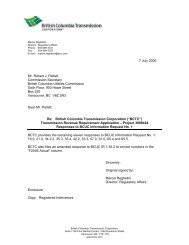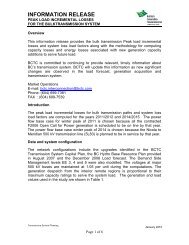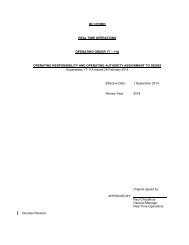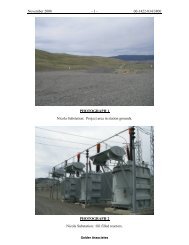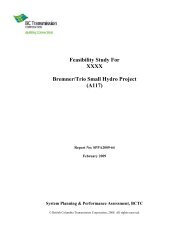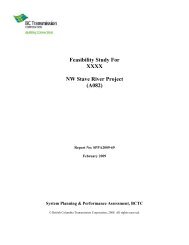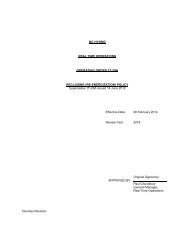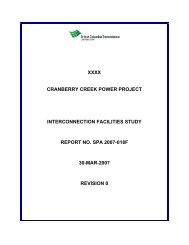Evidence on the Adequacy of First Nations Consultation - BC Hydro ...
Evidence on the Adequacy of First Nations Consultation - BC Hydro ...
Evidence on the Adequacy of First Nations Consultation - BC Hydro ...
Create successful ePaper yourself
Turn your PDF publications into a flip-book with our unique Google optimized e-Paper software.
Ano<strong>the</strong>r group <strong>of</strong> Ktunaxa, <strong>the</strong> Qatmuk’nek, also frequented <strong>the</strong> Duncan Lake vicinity during <strong>the</strong>ir<br />
seas<strong>on</strong>al transhumance between <strong>the</strong> winter ungulate range at <strong>the</strong> Columbia’s headwaters in <strong>the</strong> Rocky<br />
Mountain Trench and <strong>the</strong> summer salm<strong>on</strong> fishery <strong>of</strong> <strong>the</strong> Arrow Lakes.<br />
In <strong>the</strong> Jumbo Pass research study, 16 he and his co-authors c<strong>on</strong>clude that <strong>the</strong> Toby Creek people<br />
(whose descendants are now largely part <strong>of</strong> <strong>the</strong> Columbia Lakes Band <strong>of</strong> Windermere) have traveled<br />
through <strong>the</strong> Purcells into <strong>the</strong> Lardeau-Duncan area and <strong>on</strong> to <strong>the</strong> Arrow Lakes as a part <strong>of</strong> <strong>the</strong>ir<br />
seas<strong>on</strong>al round for a very l<strong>on</strong>g time. From pers<strong>on</strong>al observati<strong>on</strong> <strong>the</strong>y found <strong>the</strong> route from Toby<br />
Creek over <strong>the</strong> saddle <strong>of</strong> Jumbo Pass and down Glacer Valley to be topographically suitable with<br />
c<strong>on</strong>siderable supportive habitat. In additi<strong>on</strong>, a somewhat cursory examinati<strong>on</strong> yielded several sites<br />
bearing signs <strong>of</strong> pre-c<strong>on</strong>tact use.<br />
The archaeological evidence <strong>the</strong>refore is c<strong>on</strong>sistent with <strong>the</strong> noti<strong>on</strong> that, with <strong>the</strong> excepti<strong>on</strong> <strong>of</strong> <strong>the</strong><br />
recent adopti<strong>on</strong> <strong>of</strong> <strong>the</strong> horse in <strong>the</strong> eastern part <strong>of</strong> <strong>the</strong>ir range and <strong>the</strong> added focus <strong>on</strong> <strong>the</strong> buffalo hunt,<br />
<strong>the</strong> Ktunaxa first encountered by Europeans <strong>on</strong> <strong>the</strong> Columbia Plateau in <strong>the</strong> 19 th century were living<br />
in much <strong>the</strong> same way and largely in <strong>the</strong> same areas <strong>the</strong>ir ancestors had for millenia, and that a major<br />
focal point <strong>of</strong> <strong>the</strong>ir range was <strong>the</strong> upper Columbia River Valley.<br />
7. HISTORICAL OVERVIEW OF THE EUROCANADIAN IMPACT ON THE KTUNAXA<br />
Most <strong>of</strong> our early written knowledge <strong>of</strong> <strong>the</strong> traditi<strong>on</strong>al culture and inter-relati<strong>on</strong>ships <strong>of</strong> <strong>the</strong> Ktunaxa<br />
and o<strong>the</strong>r Indians <strong>of</strong> <strong>the</strong> Columbia Plateau comes to us from <strong>the</strong> observati<strong>on</strong>s <strong>of</strong> fur traders,<br />
missi<strong>on</strong>aries and adventurers who began arriving in <strong>the</strong> area in <strong>the</strong> early 1800s. 17 This was a time <strong>of</strong><br />
upheaval in western North America, arising primarily from three great impacts <strong>of</strong> Europeans up<strong>on</strong><br />
Indian culture.<br />
The descendants <strong>of</strong> horses originally taken from <strong>the</strong> extensive Spanish ranching district around Santa<br />
Fe expanded northward through <strong>the</strong> western plains, and early in <strong>the</strong> 18 th Century became a crucial<br />
part <strong>of</strong> life for those engaged in <strong>the</strong> seas<strong>on</strong>al buffalo hunts <strong>on</strong> <strong>the</strong> eastward porti<strong>on</strong>s <strong>of</strong> <strong>the</strong> Plateau and<br />
<strong>the</strong> Great Plains. 18 With ranges dramatically expanded for cultures l<strong>on</strong>g used to travelling <strong>on</strong> foot,<br />
increased competiti<strong>on</strong> for hunting territory and access to <strong>the</strong> buffalo herds so<strong>on</strong> evolved into range<br />
wars between <strong>the</strong> various tribes and an increased glorificati<strong>on</strong> <strong>of</strong> warrior culture. Into this volatile<br />
mix stepped fur traders who brought with <strong>the</strong>m trade goods and c<strong>on</strong>tagious diseases, most notably<br />
firearms and smallpox, and <strong>the</strong>se had fur<strong>the</strong>r huge impacts <strong>on</strong> <strong>the</strong> indigenous people <strong>of</strong> <strong>the</strong> Plateau.<br />
In order to assist readers with place names <strong>of</strong> <strong>the</strong> area, some <strong>of</strong> which are no l<strong>on</strong>ger found <strong>on</strong> modern<br />
maps, a detail <strong>of</strong> John Arrowsmith’s 1864 map <strong>of</strong> “The Provinces <strong>of</strong> British Columbia & Vancouver<br />
Island, with Porti<strong>on</strong>s <strong>of</strong> <strong>the</strong> United States & Huds<strong>on</strong>’s Bay Territories” is included as Figure 3.<br />
15 Choquette, 2005, p. 14<br />
16 Keefer et al, 2004, pp. 23-25<br />
17 According to Bill Brunt<strong>on</strong>, <strong>the</strong> first European c<strong>on</strong>tact with <strong>the</strong> Ktunaxa occurred in 1792 “when Peter Fidler met a<br />
small party east <strong>of</strong> <strong>the</strong> Rocky Mountains” from <strong>the</strong> Handbook <strong>of</strong> North American Indians, Volume 12, p. 232.<br />
18 For example, see Haines, Frances (1932): he attributes this spread to <strong>the</strong> frequent escapes from Spanish missi<strong>on</strong>s by<br />
indentured Indians with <strong>the</strong>ir horses and equestrian knowledge, followed by <strong>the</strong> development <strong>of</strong> systematic horse <strong>the</strong>ft,<br />
especially by <strong>the</strong> Apache. Aided greatly by <strong>the</strong> Pueblo Revolt <strong>of</strong> 1680, horses are believed to have reached <strong>the</strong> Plateau<br />
area by <strong>the</strong> 1720s, after which <strong>the</strong>y were spread north and east into Blackfoot and Cree country.<br />
11<br />
Page 155 <strong>of</strong> 200






